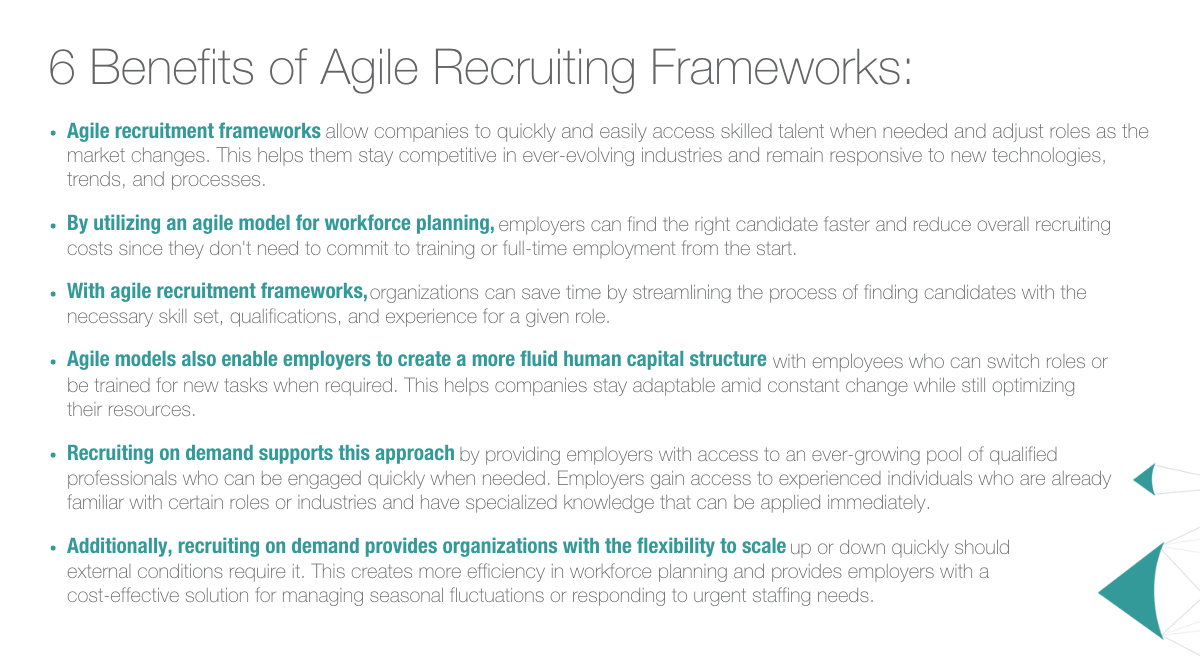Agile Recruiting Frameworks in Workforce Planning

As companies rush to modernize their workforce planning techniques, agile recruitment is emerging as a powerful asset. It expedites hiring processes and provides clear strategies and goals for businesses looking to maximize their talent pool. In this article, we’ll demystify how an agile recruiting framework works and offer helpful tips on implementing it into your business operations.
Be More Agile Than Your Competitors
Entrepreneur and investor Steve Blank remarked:
“It’s not just about being faster than competitors; it’s also about being more agile than them.”
Steve Blank presents an intriguing idea – successful companies must be smarter and faster than the competition. To do this, they must recognize how quickly their industry shifts and evolves through agile Talent Acquisition processes. This means having a readiness to swiftly source talent that meets required qualifications while ensuring efficient onboarding of new hires with minimal business disruption.
What Agile Recruiting Frameworks Can Do
Agile recruiting frameworks offer companies an innovative way to stay ahead of emerging trends and technologies. By shifting their workforce planning strategies over time, organizations are better equipped to thrive in changing markets or industries where new processes continually arise.
Agile recruitment makes it easy for organizations to fill their ranks with the needed talent and versatility. This model allows employers to develop a flexible, responsive, and well-suited workforce for quickly evolving markets – all while providing training opportunities so employees can stay ahead of changing demands.
For employers looking to attract the right talent, agile recruitment frameworks provide an effective way to streamline their search process. A flexible job description allows them to access a wider range of prospects while identifying candidates with the most pertinent qualifications and capabilities for available roles. On top of that, it enables business owners and managers to see potential opportunities for knowledge-sharing among current employees and more accurately assign tasks based on skill level needs. This ensures everyone works optimally without any bottlenecks or delays.
Click below to discover Recruiter.com’s monthly U.S. job market report based on the insights of recruiters, HR pros, and talent acquisition experts like you.
Take the Recruiter Index™ Survey Now
Benefits of Agile Recruiting Frameworks
Agile recruiting frameworks allow organizations to craft custom training journeys for each employee, taking into account their unique learning preferences. This allows managers to easily oversee onboarding progress and helps employees reach peak performance as quickly as possible through effective feedback cycles.

Learn from the Pros
Former Microsoft CEO, Satya Nadella, said it best:
“To succeed in a rapidly changing environment, we must learn to change faster than the world around us.”
This rings particularly true regarding Talent Acquisition. In this type of field, it is paramount to your success to remain proactive and seize opportunities before your competitors do. With today’s cutting-edge predictive analytics tools, leaders can spot emerging trends early on and stay one step ahead of their industry peers by ensuring they have access to the right skill sets for success.
As outlined in this post, agile recruiting frameworks are essential to building a strong and successful workforce. Using agile recruiting processes, employers can ensure that the candidates they recruit and select for open roles are the best possible match for their organization. Organizations also benefit from finding creative ways to streamline recruitment efforts, create workflows, and establish goals more efficiently.
To summarize, organizations that adopt agile recruiting frameworks will improve their ability to meet their workforce goals while increasing efficiency. All these elements lead to larger productivity gains and shorter time-to-hire cycles. Ready to get started? Download our 2023 Workforce Planning Guide today to learn how to implement agile recruiting frameworks into your organization’s recruitment plan!

